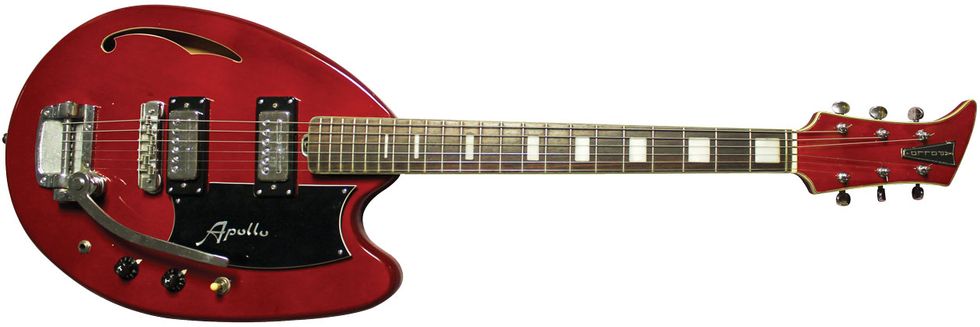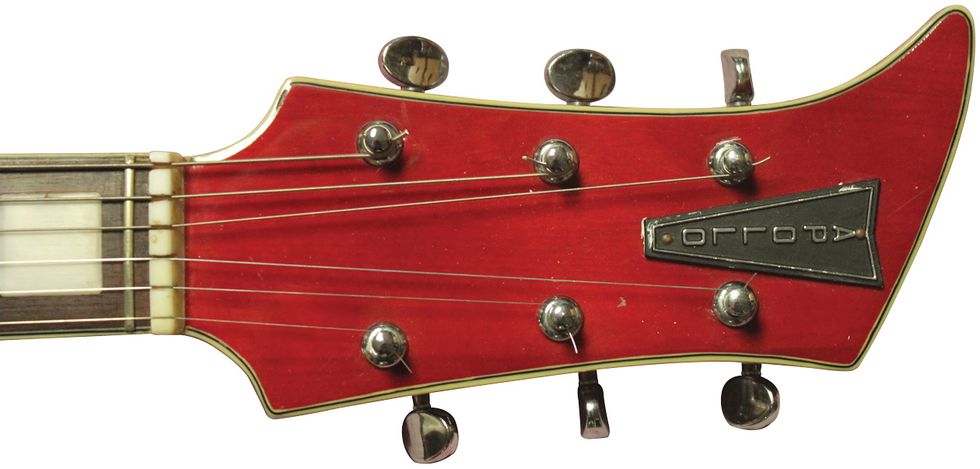The late 1960s certainly presented the world with an abundance of visually interesting guitars. Our example this month, the Apollo Red Baron (Photo 1), probably would have made Bob Ross proud, with its elongated art-palette shape. The rather elegant design has clean lines, reminiscent of a teardrop shape, with a dropped lower cutaway, but the Red Baron probably would have been hard to sell to a traditionalist even back in the day. For someone who craves the odd, however, its design is really delightfully unlike (almost) anything else ever made.
I suppose the first time I took note of this shape was in the form of the Vox Mando-Guitar, which also hailed from the 1960s. I recall thinking how cool a full-sized guitar version would be, and I soon came across the semi-famous Teisco May Queen (Photo 3), which also had this teardrop-style design. Then I discovered our Apollo Red Baron, which is nearly identical to the Teisco, but constructed a little better.
And hold on, folks, because a few years later I got wind of the Eko Auriga. The Eko design, which also included basses, was a slightly more elongated, solidbody example of the palette shape. I’m really not quite sure which of these full-sized guitars came first, but my point is that, for a short time, this design flashed across the bizarre-guitar universe. The Teisco version was probably the most common of the bunch, but there was also the Kimberly-branded version. However, in the latter’s case, a metallic Kimberly sticker was merely placed over the Teisco name.
Here in the U.S., we primarily saw the Teisco or the Apollo. The Apollo brand was distributed by St. Louis Music, and the company unleashed this rather unique guitar in their 1969 catalog, nestled among more common but cool hollowbody instruments. (As an aside, and it’s probably not a surprise, old guitar catalogs are fascinating to me. Spread throughout the pages of the St. Louis catalog, there was also the added bonus of an oh-so-’60s mustachioed model in all sorts of pained poses, pretending to be rocking out on many colorfully named guitars, including the Super Cougar and the Deadly Dozen.) The Red Baron retailed for $140 in 1969, and the catalog describes the Red Baron like this: “The guitar with the jet-stream look. Sleek styling and meticulous workmanship. Fast, slender neck with adjustable steel rod. Chrome-plated vibrato tailpiece, four-way adjustable bridge. Pickups have individual adjustable poles. Selector switch, tone and volume controls. Pearl markers on the rosewood fingerboard. Chrome patent heads. Red Baron is a real musical happening.”
I have owned both the Teisco and the Apollo, and I prefer the sound of the Red Baron much more. (Visit our online version of this column to hear it in action.) The May Queen seemed a bit weak sounding to me, and its pickups did not match the semi-hollow construction at all. The Red Baron, however, featured Hofner-esque pickups that are really strong and punchy. Even though the guitars look very similar, they are from different factories in Japan. The Teiscos were made at the Kawai factory, while the Apollos, interestingly, were made at the formerTeisco factory, which was located outside Matsumoto. And, in those days, that particular factory was making some very cool guitars for Idol, Honey, and Firstman. But let’s save those brands for some future discussions.
See and hear this 1969 Apollo Red Baron demoed by Mike Dugan.

















![Rig Rundown: Russian Circles’ Mike Sullivan [2025]](https://www.premierguitar.com/media-library/youtube.jpg?id=62303631&width=1245&height=700&quality=70&coordinates=0%2C0%2C0%2C0)



